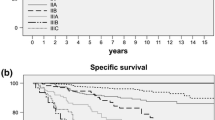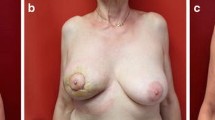Summary
This study is an attempt to evaluate the necessity of radical surgery based on the incidence of tumor remnants and lymphnode metastases in amputated breast after diagnostic excision. The material included 600 female patients, from 27–86 years old (mean age 58 years) examined at the Institute of Pathology University of Munich between 1969 and 1974. Retrospectively 36% of the specimen would have been free of tumor after en bloc resection, 21% simple mastectomy and 19% after simple mastectomy with additional axillary lymphnode disection. In fact, however, radical mastectomy was necessary in 25% for total removal of the tumor.
As no methods for exact preoperative determination of tumor extension are yet known and as there is a high risk of recurrant tumor because of insufficient excision, organ-preserving surgical procedures still will be restricted to a few individual and selected cases of breast carcinoma presuming the patients consent.
Zusammenfassung
Zur Frage der Notwendigkeit eines radikalen operativen Vorgehens beim Mammacarcinom in Anlehnung an die Halsted-Methode wird versucht, anhand der Häufigkeit von Carcinomrestgewebe in der amputierten Mamma nach vorausgegangener Probeexcision und anhand der Häufigkeit regionaler Lymphknotenmetastasen Stellung zu nehmen. Zur Auswertung kam das Gewebe von 600 Frauen im Alter von 27–86 Jahren (Durchschnittsalter 58 Jahre), welches im Zeitraum von 1969-1974 am Pathologischen Institut der Universität München untersucht worden ist. Aufgrund der morphologischen Befunde allein, also ohne Kenntnis der klinischen Stadieneinteilung, ergibt sichim Nachhinein, daß in 36% eine großzügige lokale Tumorexstirpation (en bloc-Resektion), in 21 % eine einfache Mastektomie und in 17 % eine einfache Mastektomie mit zusätzlicher Ausräumung der axillären Lymphknoten ausreichend gewesen wäre. In einem Viertel der Fälle ist in der Tat aber erst mit einer radikalen Mastektomie das Tumorgewebe entfernt gewesen. Diese Auswertungen, allein gewonnen auf dem Boden morphologischer Befunde, müssen aber solange lediglich als Denkmodell im Raum stehenbleiben, solange die derzeitigen diagnostischen Methoden nicht ausreichen, eine exakte, d. h. zweifelsfreie Abgrenzung des bösartigen Geschwulstprozesses prä- oder intraoperativ zu gewährleisten. Grundsätzlich wird weiterhin bei gesichertem Mammacarcinom das Organerhaltende operative Vorgehen dem Einzelfall, mit der Stimme der Patientin, vorbehalten bleiben müssen, da im Mittel das Risiko eines Rezidivs infolge unvollständiger Tumorerfassung bei der Erstoperation zu hoch ist.
Similar content being viewed by others
Literatur
Atkins, H., Hayward, J. L., Klugman, D. J., Wayte, A. B.: Treatment of early breast breast cancer. A report after ten years of a clinical trial. Br. Med. J.1972 II, 423–429.
Berndt, H., Friderichs, W., Gertrich, J., Schwarz, H.: Einfluh des Alters auf die Prognose des Mamma-Karzinoms. Chirurg32, 401–405 (1961)
Black, M. M., Speer, F. D.: Nuclear structure in cancer tissues. Surg. Gynec. Obstet.105, 97–102 (1957)
Crile, G., Esselstyn, C. B., Hermann, R. E., Hoerr, S. O.: Partial mastectomy for carcinoma of the breast. Surg. Gynecol. Obstet.136, 929–933 (1973)
Fisher, E., Gregorio, R., Redmond, C., Vellios, F., Sommers, S., Fisher, B.: Pathologic findings from the National Adjuvants Breast Project. (Protocol Nr. 4): I. Observations Concerning the multicentricity of mammary cancer. Cancer35, 247–254 (1975)
Gregl, A., Thorwirth, V.: Die Bedeutung der Biopsie für die Prognose des Mammakarzinoms. Dtsch. Med. Wochenschr.92, 2160–2165 (1967)
Haagensen, C. D.: The choice of treatment for operable carcinoma of the breast. Surgery76, 685–714 (1974)
Halsted, W. S.: The results of treatment for the cure of cancer of the breast performed at the Johns Hopkins Hospital from June 1889 to January 1894. Johns Hopkins Hosp. Rep.4, 297–312 (1894/95)
Hayward, J.: The conservative treatment of early breast cancer. Cancer33, 593–599 (1974)
Kammer, G., Brunner, K. W.: Neuere Aspekte der kurativen Behandlung des Mammacarcinoms. Schweiz. Med. Wochenschr.102, 1646–1653 (1972)
Knoch, H. G., Wolf, D., Kamenz, E.: Die Behandlung des Mammakarzinoms bei Greisinnen. Dtsch. Gesundh.-Wes.29, 1763–1766 (1974)
Mestwerdt, G., Link, G.: Einige klinische Erfahrungen mit der Behandlung des Mammakarzinoms während der letzten 12 Jahre. Zentralbl. Gynäkol.90, 1388–1394 (1968)
Million, R. R.: Segmental mastectomy plus radiation therapy for stage I cancer of the breast. Am. J. Clin. Path.64, 767–773 (1975)
Mustakallio, S.: Conservative treatment of breast carcinoma — review of 25 years follow up — Clin. Radiol.23, 110–116 (1972)
Patey, D. H., Dyson, W. H.: The prognosis of carcinoma of the breast in relation to the type of operation performed. Br. J. Cancer2, 7–12 (1948)
Prechtel, K., Finsterer, H.: Abklatschzytologie als Ergänzung der histologischen Diagnose von Mammaexcisionen. Verb. Dtsch. Ges. Path.57, 357–359 (1973)
Rosen, P., Fracchia, A., Urban, J., Schottenfeld, D., Robbins, G.: Residual mammary carcinoma following simulated partial mastectomy. Cancer35, 739–747 (1975)
Sack, H., Scherer, E.: Klinisch-methodische überlegungen zur postoperativen Strahlenbehandlung des Brustkrebses mit konventionellen und Hochvoltmethoden. Strahlentherapie143, 473–484 (1972)
Shah, J. P., Rosen, P. P., Robbins, G. F.: Pitfalls of local excision in the treatment of carcinoma of the breast. Surg. Gynecol. Obstet.136, 721–725 (1973)
Silverberg, S. G., Chitale, A. R.: Assessment of significance of proportions of intraductal and infiltrating tumor growth in ductal carcinoma of the breast. Cancer32, 830–837 (1973)
Stegner, H. E.: Pathologisch-anatomische Aspekte der organerhaltenden (konservierenden) Therapie bei Karzinomfrühstadien der Mamma. Österr. Z. Onkol.2, 136–144 (1974)
Zippel, H. H., Citoler, P.: Häufigkeit des lokal begrenzten Wachstums von Mammakarzinomen. Dtsch. Med. Wochenschr.101, 484–486 (1976)
Author information
Authors and Affiliations
Additional information
Auszug aus der Dissertation von Frl. C. Gross, Fachbereich Medizin der Ludwig-Maximilians-Universität München (1977)
Frau B. Kehoe, med. techn. Assistentin, sei an dieser Stelle für die Mitarbeit bei der Archivierung gedankt
Rights and permissions
About this article
Cite this article
Prechtel, K., Gross, C. Pathologisch-anatomische Aspekte zu gewebeschonenden Operationen beim Mammacarcinom der Frau. Langenbecks Arch Chiv 344, 281–291 (1978). https://doi.org/10.1007/BF01261266
Received:
Issue Date:
DOI: https://doi.org/10.1007/BF01261266




